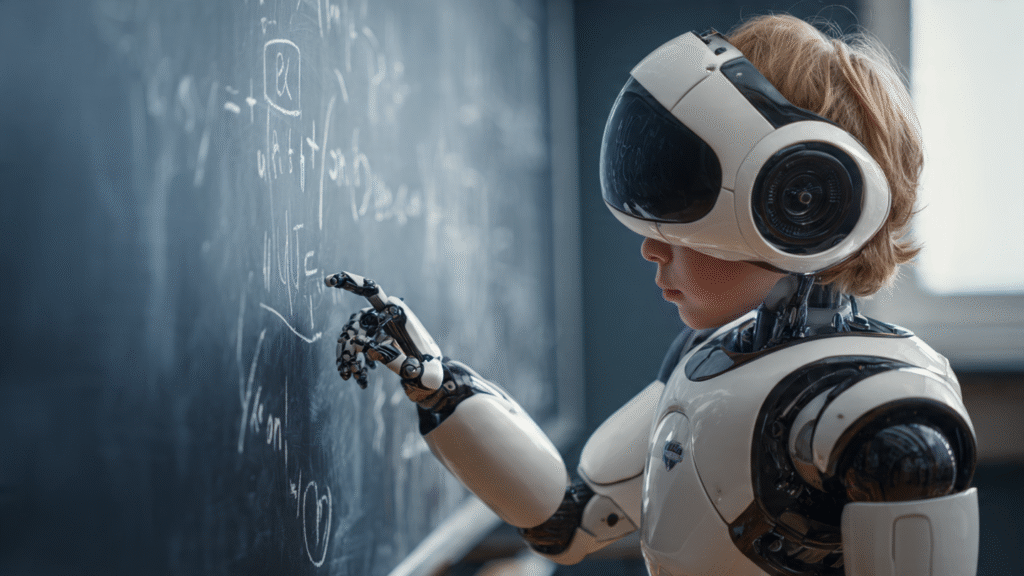
In 2025, classrooms no longer look the same. Blackboards have been replaced by smart screens, homework is checked by AI (to test about human touch), and students receive personalized feedback in real time. Artificial Intelligence (AI) is transforming school education in ways we once thought were science fiction.
While AI offers powerful tools to enhance learning, it also brings new challenges that schools, teachers, parents, and policymakers must address.
Let’s explore how AI is reshaping school education in 2025—its impact and the challenges that come with it.
✅ The Impact of AI on School Education
1. 🎯 Personalized Learning for Every Student
AI systems now tailor lessons based on a student’s pace, strengths, and weaknesses. Platforms use real-time data to adjust difficulty levels and suggest activities that keep students engaged and progressing.
Example: A 7th-grade student struggling with fractions might receive extra practice problems and videos, while another student moves ahead to more complex math concepts.
2. 📊 Smart Assessment and Instant Feedback
AI-powered tools grade assignments, quizzes, and even essays instantly. Students receive immediate feedback, helping them learn from mistakes without waiting days for results.
Teachers also benefit—they can track performance patterns and adjust instruction for individuals or entire classes.
3. 🤖 AI-Powered Virtual Tutors & Assistants
Students now have access to AI tutors 24/7. These bots can answer questions, explain concepts, or guide students through practice problems, just like a real tutor—but without scheduling conflicts or cost barriers.
4. 🧠 Enhanced Support for Special Needs
AI-driven tools provide speech-to-text, text-to-speech, real-time translation, and emotion recognition to support students with learning disabilities, language barriers, or emotional challenges.
For example, a student with dyslexia can listen to AI-narrated textbooks, helping them stay on pace with classmates.
5. 🌍 Bridging the Learning Gap in Remote Areas
AI combined with cloud-based platforms brings quality education to underserved regions. Interactive, AI-supported lessons can be accessed via smartphones or low-cost devices, minimizing the urban-rural education divide.
⚠️ Challenges in AI-Driven School Education
While the potential is exciting, AI also introduces serious concerns that need to be addressed in 2025 and beyond.
1. 🔐 Data Privacy and Security
AI systems collect massive amounts of student data—grades, behavior, learning habits, and more. Without strict regulations, this data could be misused or breached.
Parents and schools are raising concerns: Who owns the data? How is it stored? Who has access?
2. 🧑🏫 Role of Teachers: Replaced or Reinvented?
AI is not meant to replace teachers—but there’s anxiety about automation. In reality, the teacher’s role is evolving from “instructor” to “mentor and guide.”
Teachers must now be trained to use AI tools effectively and ethically—a skill gap that many education systems are still addressing.
3. 💻 Inequality in Tech Access
Not all students have equal access to AI tools. Some lack reliable internet, devices, or even electricity. This “digital divide” risks leaving behind the very students AI is meant to help.
4. 📉 Over-reliance on Algorithms
AI can predict what a student might struggle with—but it can’t understand the full emotional or social context of a learner. Overusing AI may lead to rigid learning paths and reduced creativity.
Human judgment, empathy, and critical thinking must stay at the core of education.
5. ⚖️ Ethical Concerns and Bias
AI systems can reflect biases in their training data. If not properly designed, they might reinforce stereotypes or disadvantage certain groups.
A biased grading algorithm or recommendation system could unfairly impact student outcomes.
🚀 Looking Ahead: The Future of AI in Education
The AI-driven classroom of 2025 is just the beginning. As technology evolves, we can expect even more innovation:
- AI-powered emotional intelligence tools that detect stress and offer mental health support.
- Augmented Reality (AR) and AI combined for immersive, hands-on learning experiences.
- AI helping design individual career paths starting from school.
But to unlock this future responsibly, we need balanced policies, ethical standards, and continuous teacher training.
🧠 Final Thoughts
AI has the power to revolutionize school education—making it more personalized, inclusive, and efficient. In 2025, we’re already seeing the positive impact in classrooms around the world. But we must not ignore the ethical, social, and practical challenges that come with it.
The goal is not to let machines take over education—but to use them wisely, so every student, regardless of background, has a fair chance to learn, grow, and succeed.
